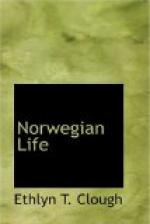When a person is very sick, he is taken to a hospital. Sweden has some of the best hospitals in the world. His own doctor looks after him there, assisted by the house physician and nurses, who expect fees, but the regular doctor gets none. He supervises the treatment and acts as adviser to the house physician.
The government pays subsidies to doctors in remote parts of the country, just as it pays the salaries of the ministers where the people are so poor that they can not support a doctor and a parson. In fact, all the clergymen of the established church are paid by the government and are government officials. The members of their parishes give them presents, something on the donation party order, because their salaries are small, and if there happen to be rich men in the parish, it is their custom to send around a handsome present to the minister’s wife or to himself on Christmas Day.
The Swedes have a short summer, and so far as possible spend it in the open air. Every citizen of Stockholm who can afford it has a place in the country, no matter how humble or primitive it may be, and if he can not afford a cabin, he pitches a tent in the woods under the pine trees, and if necessary cooks his own meals. The banks of the lakes and rivers throughout the entire kingdom—and there are more than 1,400 lakes in Sweden and 1,700 islands in the Stockholm Skaergard—are surrounded by such dwellings and camps, for the Swedes love the water. Those who are compelled to remain in town take their meals and spend their evenings at the open-air cafes, which are found in every part of the city with bands of music, and take daily excursions on the boats which ply through the fjord and the lakes which encircle the town. In the suburbs are circuses, open-air theaters, concert gardens, and other forms of entertainments, simple and serious. A number of fine restaurants are maintained in the parks, where people can get a good dinner and spend the evening under the cool foliage, listening to an orchestral concert or a band. Every form of outdoor amusement is furnished, and the people eat, drink, and are merry, making the most of their time from June to September before the long and dreary winter comes upon them.




